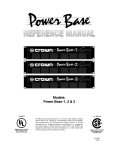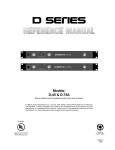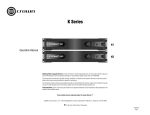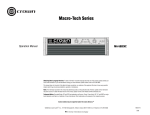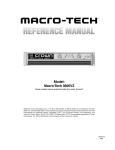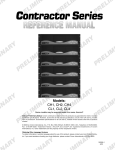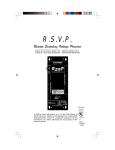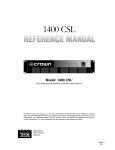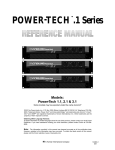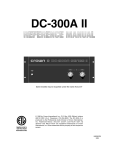Download Crown D Series Specifications
Transcript
D SEries 30 50 HEADPHONES CHANNEL 1 20 40 0 OFF IOC SIGNAL ON 20 40 50 10 LEVEL 30 CHANNEL 2 10 LEVEL 0 POWER Models: D-45 & D-75A Some models may be exported under the name Amcron.® ©1999 by Crown International, Inc., P.O. Box 1000, Elkhart, Indiana 46515-1000 U.S.A. Telephone: 219-294-8000. D Series amplifiers are produced by the Professional Audio Division of Crown International, Inc. Trademark Notice: Amcron,® Crown® and IOC ® are registered trademarks of Crown International, Inc. Other trademarks are the property of their respective owners. Printed on recycled paper. 125243-3 8/99 3 YEAR THREE YEAR FULL WARRANTY 3 YEAR WORLDWIDE NORTH AMERICA SUMMARY OF WARRANTY The Crown Audio Division of Crown International, Inc., 1718 West Mishawaka Road, Elkhart, Indiana 46517-4095 U.S.A. warrants to you, the ORIGINAL PURCHASER and ANY SUBSEQUENT OWNER of each NEW Crown1 product, for a period of three (3) years from the date of purchase by the original purchaser (the “warranty period”) that the new Crown product is free of defects in materials and workmanship, and we further warrant the new Crown product regardless of the reason for failure, except as excluded in this Crown Warranty. SUMMARY OF WARRANTY The Crown Audio Division of Crown International, Inc., 1718 West Mishawaka Road, Elkhart, Indiana 46517-4095 U.S.A. warrants to you, the ORIGINAL PURCHASER and ANY SUBSEQUENT OWNER of each NEW Crown product, for a period of three (3) years from the date of purchase by the original purchaser (the “warranty period”) that the new Crown product is free of defects in materials and workmanship. We further warrant the new Crown product regardless of the reason for failure, except as excluded in this Warranty. 1 Note: If your unit bears the name “Amcron,” please substitute it for the name “Crown” in this warranty. ITEMS EXCLUDED FROM THIS CROWN WARRANTY This Crown Warranty is in effect only for failure of a new Crown product which occurred within the Warranty Period. It does not cover any product which has been damaged because of any intentional misuse, accident, negligence, or loss which is covered under any of your insurance contracts. This Crown Warranty also does not extend to the new Crown product if the serial number has been defaced, altered, or removed. ITEMS EXCLUDED FROM THIS CROWN WARRANTY This Crown Warranty is in effect only for failure of a new Crown product which occurred within the Warranty Period. It does not cover any product which has been damaged because of any intentional misuse, accident, negligence, or loss which is covered under any of your insurance contracts. This Crown Warranty also does not extend to the new Crown product if the serial number has been defaced, altered, or removed. WHAT THE WARRANTOR WILL DO We will remedy any defect, regardless of the reason for failure (except as excluded), by repair, replacement, or refund. We may not elect refund unless you agree, or unless we are unable to provide replacement, and repair is not practical or cannot be timely made. If a refund is elected, then you must make the defective or malfunctioning product available to us free and clear of all liens or other encumbrances. The refund will be equal to the actual purchase price, not including interest, insurance, closing costs, and other finance charges less a reasonable depreciation on the product from the date of original purchase. Warranty work can only be performed at our authorized service centers. We will remedy the defect and ship the product from the service center within a reasonable time after receipt of the defective product at our authorized service center. WHAT THE WARRANTOR WILL DO We will remedy any defect, regardless of the reason for failure (except as excluded), by repair, replacement, or refund. We may not elect refund unless you agree, or unless we are unable to provide replacement, and repair is not practical or cannot be timely made. If a refund is elected, then you must make the defective or malfunctioning product available to us free and clear of all liens or other encumbrances. The refund will be equal to the actual purchase price, not including interest, insurance, closing costs, and other finance charges less a reasonable depreciation on the product from the date of original purchase. Warranty work can only be performed at our authorized service centers or at the factory. We will remedy the defect and ship the product from the service center or our factory within a reasonable time after receipt of the defective product at our authorized service center or our factory. All expenses in remedying the defect, including surface shipping costs in the United States, will be borne by us. (You must bear the expense of shipping the product between any foreign country and the port of entry in the United States and all taxes, duties, and other customs fees for such foreign shipments.) HOW TO OBTAIN WARRANTY SERVICE You must notify us of your need for warranty service not later than ninety (90) days after expiration of the warranty period. All components must be shipped in a factory pack. Corrective action will be taken within a reasonable time of the date of receipt of the defective product by our authorized service center. If the repairs made by our authorized service center are not satisfactory, notify our authorized service center immediately. HOW TO OBTAIN WARRANTY SERVICE You must notify us of your need for warranty service not later than ninety (90) days after expiration of the warranty period. All components must be shipped in a factory pack, which, if needed, may be obtained from us free of charge. Corrective action will be taken within a reasonable time of the date of receipt of the defective product by us or our authorized service center. If the repairs made by us or our authorized service center are not satisfactory, notify us or our authorized service center immediately. DISCLAIMER OF CONSEQUENTIAL AND INCIDENTAL DAMAGES YOU ARE NOT ENTITLED TO RECOVER FROM US ANY INCIDENTAL DAMAGES RESULTING FROM ANY DEFECT IN THE NEW CROWN PRODUCT. THIS INCLUDES ANY DAMAGE TO ANOTHER PRODUCT OR PRODUCTS RESULTING FROM SUCH A DEFECT. DISCLAIMER OF CONSEQUENTIAL AND INCIDENTAL DAMAGES YOU ARE NOT ENTITLED TO RECOVER FROM US ANY INCIDENTAL DAMAGES RESULTING FROM ANY DEFECT IN THE NEW CROWN PRODUCT. THIS INCLUDES ANY DAMAGE TO ANOTHER PRODUCT OR PRODUCTS RESULTING FROM SUCH A DEFECT. SOME STATES DO NOT ALLOW THE EXCLUSION OR LIMITATIONS OF INCIDENTAL OR CONSEQUENTIAL DAMAGES, SO THE ABOVE LIMITATION OR EXCLUSION MAY NOT APPLY TO YOU. WARRANTY ALTERATIONS No person has the authority to enlarge, amend, or modify this Crown Warranty. This Crown Warranty is not extended by the length of time which you are deprived of the use of the new Crown product. Repairs and replacement parts provided under the terms of this Crown Warranty shall carry only the unexpired portion of this Crown Warranty. DESIGN CHANGES We reserve the right to change the design of any product from time to time without notice and with no obligation to make corresponding changes in products previously manufactured. LEGAL REMEDIES OF PURCHASER No action to enforce this Crown Warranty shall be commenced later than ninety (90) days after expiration of the warranty period. THIS STATEMENT OF WARRANTY SUPERSEDES ANY OTHERS CONTAINED IN THIS MANUAL FOR CROWN PRODUCTS. 9/90 WARRANTY ALTERATIONS No person has the authority to enlarge, amend, or modify this Crown Warranty. This Crown Warranty is not extended by the length of time which you are deprived of the use of the new Crown product. Repairs and replacement parts provided under the terms of this Crown Warranty shall carry only the unexpired portion of this Crown Warranty. DESIGN CHANGES We reserve the right to change the design of any product from time to time without notice and with no obligation to make corresponding changes in products previously manufactured. LEGAL REMEDIES OF PURCHASER THIS CROWN WARRANTY GIVES YOU SPECIFIC LEGAL RIGHTS, YOU MAY ALSO HAVE OTHER RIGHTS WHICH VARY FROM STATE TO STATE. No action to enforce this Crown Warranty shall be commenced later than ninety (90) days after expiration of the warranty period. THIS STATEMENT OF WARRANTY SUPERSEDES ANY OTHERS CONTAINED IN THIS MANUAL FOR CROWN PRODUCTS. Telephone: 219-294-8200. Facsimile: 219-294-8301 Telephone: 219-294-8200. Facsimile: 219-294-8301 9/90 The information furnished in this manual does not include all of the details of design, production, or variations of the equipment. Nor does it cover every possible situation which may arise during installation, operation or maintenance. If you need special assistance beyond the scope of this manual, please contact our Technical Support Group. Crown Audio Division Technical Support Group Plant 2 SW, 1718 W. Mishawaka Rd., Elkhart, Indiana 46517 U.S.A. Phone: 800-342-6939 (North America, Puerto Rico and Virgin Islands) or 219-294-8200 Fax: 219-294-8301 Fax Back (North America only): 800-294-4094 or 219-293-9200 Fax Back (International): 219-294-8100 Internet: http://www.crownaudio.com CAUTION AVIS RISK OF ELECTRIC SHOCK DO NOT OPEN RISQUE DE CHOC ÉLECTRIQUE N’OUVREZ PAS TO PREVENT ELECTRIC SHOCK DO NOT REMOVE TOP OR BOTTOM COVERS. NO USER SERVICEABLE PARTS INSIDE. REFER SERVICING TO QUALIFIED SERVICE PERSONNEL. DISCONNECT POWER CORD BEFORE REMOVING BACK PANEL COVER TO ACCESS GAIN SWITCH. À PRÉVENIR LE CHOC ÉLECTRIQUE N’ENLEVEZ PAS LES COUVERCLES. IL N’Y A PAS DES PARTIES SERVICEABLE À L’INTÉRIEUR. TOUS REPARATIONS DOIT ETRE FAIRE PAR PERSONNEL QUALIFIÉ SEULMENT. DÉBRANCHER LA BORNE AVANT D’ENLEVER LA COVERTURE EN ARRIÈRE. Magnetic Field WARNING TO REDUCE THE RISK OF ELECTRIC SHOCK, DO NOT EXPOSE THIS EQUIPMENT TO RAIN OR MOISTURE! The lightning bolt triangle is used to alert the user to the risk of electric shock. CAUTION! Do not locate sensitive high-gain equipment such as preamplifiers or tape decks directly above or below the unit. Because this amplifier has a high power density, it has a strong magnetic field which can induce hum into unshielded devices that are located nearby. The field is strongest just above and below the unit. If an equipment rack is used, we recommend locating the amplifier(s) in the bottom of the rack and the preamplifier or other sensitive equipment at the top. The exclamation point triangle is used to alert the user to important operating or maintenance instructions. D-45 / D-75A Power Amplifiers Important Safety Instructions 1) Read these instructions. 2) Keep these instructions. 3) Heed all warnings. 4) Follow all instructions. 5) Do not use this apparatus near water. 6) Clean only with a dry cloth. 7) Do not block any ventilation openings. Install in accordance with the manufacturer’s instructions. 8) Do not install near any heat sources such as radiators, heat registers, stoves, or other apparatus that produce heat. 9) Do not defeat the safety purpose of the polarized or grounding-type plug. A polarized plug has two blades with one wider than the other. A groundingtype plug has two blades and a third grounding prong. The wide blade or the third prong is provided for your safety. If the provided plug does not fit into your outlet, consult an electrician for replacement of the obsolete outlet. 10) Protect the power cord from being walked on or pinched, particularly at plugs, convenience receptacles, and the point where they exit from the apparatus. 11) Only use attachments/accessories specified by the manufacturer. 12) Unplug this apparatus during lightning storms or when unused for long periods of time. 13) Refer all servicing to qualified service personnel. Servicing is required when the apparatus has been damaged in any way, such as power-supply cord or plug is damaged, liquid has been spilled or objects have fallen into the apparatus, the apparatus has been exposed to rain or moisture, does not operate normally, or has been dropped. Page 4 D-45 / D-75A Power Amplifiers Fig. 1.1 Front and Back Views 1 Welcome Reliability is the first thing you get with your purchase of a Crown power amplifier. The D-45 and D-75A both deliver dependable operation with a wide variety of loads. Because of their exceptional reliability, these amplifiers have become the leading choice of professionals for use in recording studios, laboratories and public facilities. You can even find them on the road. Their sonic excellence also makes them a very good choice for your personal listening pleasure. The D-45 and D-75A amplifiers are compact and provide ultra-low distortion for medium power applications. Crown’s advanced AB+B circuitry ensures efficient operation and protects against shorted, open, mismatched or low-impedance loads that can affect any amplifier’s performance. Crown further protects your investment with the industry’s only three year “No-Fault” full warranty. After learning about your amplifier’s features, facilities and capabilities, you’ll understand why Crown power amplifiers have long been recognized as the worldwide standard for audio excellence. For your protection, please send in your warranty registration card today and save your bill of sale as it is your official proof of purchase. shipping damage. Even if the unit arrived in perfect condition, as most do, save all packing materials so you will have them if you ever need to transport the unit. NEVER SHIP THE UNIT WITHOUT THE FACTORY PACK. 1.2 Features Your dual-channel (stereo) amplifier can optionally be configured to deliver double the power from a single (mono) channel. It also provides the following features: ❏ Powerful AB+B class circuitry yields maximum efficiency with minimum crossover “notch” distortion. ❏ IOC ® (Input/Output Comparator) alerts of any distortion that exceeds 0.05% to provide proof of distortion-free performance. ❏ Signal presence indicators verify the presence of amplifier output. ❏ Detented level controls for precise repeatability. ❏ Ultra-low harmonic and intermodulation distortion result in the best dynamic transfer function in the industry. ❏ Very low noise and wide dynamic range exceed the audio specifications for digital compact discs (CDs). ❏ High damping factor provides exceptional loudspeaker motion control. 1.1 Unpacking Please unpack and inspect your new amplifier for any damage that may have occurred during transit. If damage is found, notify the transportation company immediately. Only you, the consignee, may initiate a claim for ❏ Convection cooling system dissipates heat through the heat sinks and chassis for optimal cooling and maintenance-free operation. ❏ Mounts in a standard 19-inch (48.3-cm) rack. ❏ Three year “No-Fault” full warranty protects your investment and guarantees the specifications of units in North America and other select countries. Page 5 D-45 / D-75A Power Amplifiers 2 Installation D-45 and D-75A amplifiers are designed for standard 19 inch (48.3 cm) rack mounting, or they can be stacked without a cabinet. Before mounting your amplifier, determine whether you need to change the amplifier’s internal settings for your application. tors are located on the back panel. If you are making changes to a unit that is already installed, make sure the power is disconnected and the level controls are turned down. Following these precautions will reduce the chance of loud blasts and loudspeaker damage. The amplifier’s internal settings make it possible for you to operate the unit in bridge-mono mode and to change the unit’s input sensitivity to 0.775 volts. If you need maximum power from a single channel, you will probably want to use the bridge-mono mode. In contrast, few applications will require you to change the input sensitivity. If you need to configure the amplifier for bridge-mono mode, or if you want more specific information on your amplifier’s input sensitivity, please refer to Appendix A before proceeding. Please use care when making connections, selecting signal sources and controlling the output level. The load you save may be your own! Crown is not liable for damage to other system components due to careless amplifier use or overpowering. 2.1 Mounting Your amplifier should be mounted in a standard 19 inch (48.3 cm) equipment rack. It occupies only 1.75 inches (4.45 cm) of vertical rack space. Mounting screws and washers are provided with the amplifier. Although units can be stacked, this practice is not recommended. Instead, mount multiple units in a rack leaving air space between them. Also, before mounting the amplifier, please read about the amplifier’s cooling requirements in the section that follows. CAUTION: Be careful using headphones. Too much power can cause permanent hearing loss. 2.3.1 Mode of Operation Your amplifier may be operated in either dual or bridgemono mode. Configuration of the dual/mono jumper is described in Appendix A. Dual and bridge-mono modes have important wiring differences, so be sure to note the requirements for the mode you select. DUAL Dual mode installation is very intuitive. The channel 1 input feeds the channel 1 output, and the channel 2 input feeds the channel 2 output. Use two-conductor cable to connect loudspeakers to the amplifier’s output terminals. Be careful not to short the outputs together, and observe correct loudspeaker polarity. CAUTION: Do not tie the two outputs together. Never tie an output to another amplifier’s output. Fig. 2.1 Mounting Dimensions 2.2 Cooling Your amplifier does not have a cooling fan. To prevent overheating, sufficient ventilation is required. Equipment racks or cabinets should have perforated top and bottom panels. This is very important if more than one unit will be mounted in a rack. We recommend allowing a 1.75 inch (4.45 cm) space above and below the unit if it will be operated continuously at high output levels. 2.3 Wiring Figure 2.2 shows two of the most common ways to install your amplifier in a sound system. Except for the stereo headphone jack, all input and output connecPage 6 MONO Installation in bridge-mono mode is very different from dual mode. First, only the channel 1 input should be used. Do not use the channel 2 input. For best results, disconnect all input sources to channel 2 and turn off the channel 2 level control (fully counterclockwise). Note: The channel 2 input and level control are not defeated in bridge-mono mode. A signal feeding channel 2 will work against the signal feeding channel 1. Connect loudspeaker cables to the positive (+) output terminals as shown in Figure 2.2 in the bottom illustration. Do not use or short the negative (–) terminals. The bridge-mono output is balanced, and should remain isolated from the chassis and input signal grounds. CAUTION: Only connect balanced loads to a bridgemono output. Output lines must be isolated from ground or severe oscillations may occur. If your loudspeakers don’t need the additional voltage, and you only have one input signal to drive multiple D-45 / D-75A Power Amplifiers Fig. 2.2 System Connection loudspeakers, you can use bridge-mono mode without actually bridging the outputs. Bridge-mono mode is like dual mode except the channel 1 input feeds both outputs, and the channel 2 output is inverted. To use bridge-mono mode without bridging the outputs, wire your loudspeakers as you would for dual mode, but invert the polarity of the channel 2 output wiring (positive goes to negative, and negative goes to positive). 2.3.2 Input Connection The balanced combination XLR/phone inputs have a typical impedance of 20 K ohms. With unbalanced wiring, input impedance is typically 10 K ohms. The line level output from most devices is sufficient to drive the inputs. The XLR connectors are wired with pin 1 as ground, pin 2 as positive (+) and pin 3 as negative (–); the phone connectors are wired with tip as positive (+), ring as negative (–) and sleeve as ground. Be sure to use shielded cables with unbalanced sources. Input Wiring Tips 1. Use only shielded cable. 2. Avoid unbalanced lines longer than 10 feet (3 meters). 3. Keep signal and power wiring apart. 4. Turn off the unit before making connections. Crown is not liable for injury or damage due to overdriven components. CAUTION: Never connect input and output grounds together. Page 7 D-45 / D-75A Power Amplifiers 2.3.3 Output Connection There are many methods that can be used to prevent potential output problems, but the most important preventative measure is to use good common sense. Use Good Connectors 1. To prevent possible short circuits, do not expose the loudspeaker cable connectors. 2. Do not use connectors that might accidentally tie conductors together when making or breaking connections (for example, a standard three-wire stereo phone plug). 3. Never use connectors that can be plugged into an AC power receptacle. codes. 120 VAC, 60 Hz North American units do not have a convertible transformer, and cannot be used at other voltages and frequencies. International units can be operated with an AC mains frequency of 50 to 400 Hz, and can be configured for five different line voltages: 100, 120, 200, 220 and 240 VAC. The back panel sticker indicates the unit’s factory configuration. WARNING: Risk of electric shock! Only a competent technician should attempt to alter your amplifier’s AC mains voltage configuration. To operate an international unit at a different line voltage, you will need a phillips screwdriver and a soldering iron. Then follow these steps: 4. Avoid connectors with low current-carrying capacity. 1. Turn off the amplifier and disconnect it from the AC mains. 5. Do not use connectors with any tendency to short. 2. Remove the top cover by removing the six screws that hold it in place. High-frequency oscillations can cause your amplifier to prematurely activate its protection circuitry. To prevent high-frequency oscillations, follow these guidelines: 1. If you have long cable runs or different amplifiers sharing a common tray or jacket, use tie-wraps to bundle together loose pairs of loudspeaker conductors. (Do not bundle wires from different amplifiers.) This reduces the chance of conductors acting like antennas to transmit or receive the high frequencies that can cause oscillation. 2. Avoid using shielded loudspeaker cable. 3. Never tie together input and output grounds. 4. Never tie together the output of different amplifiers. 5. Keep output cables separated from input cables. 6. Install a low-pass filter in series with each input. 7. Install the input wiring according to the instructions in Section 2.3.2. 2.3.4 AC Mains Voltage Configuration North American 120 VAC, 60 Hz units have a standard three wire, grounded AC plug as specified by UL requirements. The 120 volt models and the European models have the appropriate plug. The other 200, 220 and 240 volt models have a North American 120 volt plug. The installer must cut off the plug and supply and install a plug appropriate for the installation. Note: Crown assumes no liability whatsoever for ungrounded operation, nor for violation of UL or local electrical Page 8 Fig. 2.3 AC Mains Voltage Conversion D-45 / D-75A Power Amplifiers 3. With the unit’s top side up and the front panel toward you, locate the terminal strip toward the front of the amplifier on your right. 4. Using a soldering iron, change the appropriate jumpers for the desired operating voltage (see Figure 2.3). e to only install the appr opriate fuse: 5. Be sur sure appropriate 100 or 120 volt mains: 2 Amp type 3AG. North American 200, 220 and 240 volt mains: 1 Amp type 3AG. European 220 or 240 volt mains: 1 Amp IEC type T, time lag, low breaking capacity. 6. Carefully check all connections. 7. Repeat steps 1 and 2 in reverse order to reassemble the unit. 3 Operation 3.1 Precautions Although your amplifier is well-protected from any external faults, we recommend that you take the following precautions for safe operation: 1. When the level of an input source is uncertain, or an audio component has not previously been used with your amplifier, always begin with the level controls at a minimum and gradually increase them while monitoring the output level. This helps to avoid possible loudspeaker blasts. 2. Don’t forget, your amplifier does not have a turnon delay. Beware of turn-on transients from other equipment ahead of the amplifier—always turn the amplifier on after other equipment has stabilized. 10. Never short an output ground lead to the input signal ground or oscillations may result. 11. The D-45 and D-75A amplifiers are not recommended for use at frequencies above 30 kHz. 12. Tampering with the circuitry or making unauthorized circuit changes may be hazardous and invalidates all agency listings. 3.2 Indicators 3. Turn off the amplifier and unplug it from the AC mains before replacing the fuse, installing an input sensitivity jumper or changing the position of the dual/mono jumper. Your amplifier has five front panel indicators. First, a power indicator behind the front panel becomes visible when the unit is turned on and has power. A signal indicator for each channel flashes when there is output from the amplifier. The IOC (Input/Output Comparator) indicators work like sensitive distortion meters and flash when the amplifier causes any distortion of 0.05% or more. The IOC indicators typically glow for about one minute after the AC power is turned off. 4. There are important differences between dual and mono wiring. Refer to Section 2.3. 3.3 Controls 5. Operate the amplifier with the correct fuse. Refer to Section 3.5. 6. When driving transformer-coupled devices (such as electrostatic loudspeakers) or other loads of less than 3 ohms, install an isolating capacitor in series with the positive (+) output. Such operation may damage the load and needlessly activate the amplifier’s V-I limiting. 7. Operate the amplifier with AC mains of no more than 10% above the rated line voltage and at the specified line frequency. 8. Never connect the output to a power supply output, battery or power main. This can cause electric shock and damage to the amplifier. 9. Do not expose the amplifier to corrosive chemicals such as soft drinks, lye, salt water, etc. Fig. 3.1 Visible Indicators A power switch and detented level controls are located on the front panel. When you power up the amplifier, remember that the unit does not have a turn-on delay. Each channel has its own level control which is used to adjust the desired output level. Both level controls are used in dual mode, but only the channel 1 control should be used in bridge-mono mode. Channel 2 control should be fully counter-clockwise in bridge-mono mode. Page 9 D-45 / D-75A Power Amplifiers The amplifier is switched between dual and bridgemono operation with the dual/mono jumper located inside the amplifier (see Appendix A). 3.5 Fuse Replacement The unit’s input gain is 26 dB as determined by 1% precision resistors in the feedback loop. This can be changed to a sensitivity of 0.775 volts by following the instructions provided in Appendix A. The AC mains fuse is located on the back panel beside the power cord. This fuse will not blow unless something is wrong. Before replacing the unit’s fuse, you should be sure to fix the source of the problem. If the problem is not immediately apparent, the unit probably needs to be serviced by a qualified technician. 3.4 Protection WARNING: Always unplug the amplifier from the AC mains before removing the fuse. Your amplifier is protected against all common hazards that plague high-power amplifiers, including shorted, open or mismatched loads; overloaded power supplies, chain destruction phenomena, input overload and high-frequency blowups. Protection against shorted and mismatched loads is provided by an instantaneous limiter that automatically limits current to the maximum safe value for the output transistors. With a loudspeaker, you can tell the amplifier has activated load protection because it causes audible distortion. The noise might be compared to crossover notch distortion or a snapping sound, depending on the load characteristics. Loudspeaker systems with impedances of 4 ohms or higher should not activate the protection system. All voltage amplification circuitry is designed to limit current. So in the extremely unlikely event of a device failure, the amplifier will prevent further damage. The input stages are protected from overload damage by series resistors. The unit also features a controlled slew rate and a V-I limiter that protect the amplifier from highfrequency (RF) blowups. Page 10 To replace the fuse, turn off the power switch and disconnect the power plug from the AC mains. Unscrew the fuse holder cap and remove the fuse. Install appropriate fuse: 100 or 120 volt mains: 2 Amp type 3AG. North American 200, 220 and 240 volt mains: 1 Amp type 3AG. European 220 or 240 volt mains: 1 Amp IEC type T, time lag, low breaking capacity. Then, simply resecure the fuse holder cap and reconnect the AC mains. IMPORTANT: Never install a fuse that has a higher current rating than the recommended value. IMPORTANT: The 3AG and IEC fuses are different physical sizes and require different holder caps. D-45 / D-75A Power Amplifiers 4 Specifications Note: The following specifications apply to all units in dual mode with both channels driven into 8 ohm loads and an input sensitivity of 26 dB gain unless otherwise specified. Standard 1 kHz Power: This term refers to maximum average power in watts at 1 kHz with 0.1% THD. Full Bandwidth FTC Power: This term refers to standard FTC power in watts from 20 Hz to 20 kHz with 0.1% THD. 120 VAC, 60 Hz Units: These North American units have dedicated transformers for 120 VAC, 60 Hz power mains. Bridge-Mono mode: 70 watts into 8 ohms. 50 watts into 16 ohms. D-75A: Dual mode (both channels driven): 55 watts into 4 ohms. 40 watts into 8 ohms. 25 watts into 16 ohms. Bridge-Mono mode: 110 watts into 8 ohms. 80 watts into 16 ohms. International Units: These units have a convertible transformer for 100, 120, 200, 220 and 240 VAC, 50 to 400 Hz power mains. Load Impedance: Safe with all types of loads. Rated for 4 to 16 ohms in dual mode, and 8 to 16 ohms in bridge-mono mode. Performance Required AC Mains: 100, 120, 200, 220 and 240 VAC (±10%), 50 to 400 Hz for international units (depending on the transformer configuration). North American 120 VAC, 60 Hz units are not convertible and can only be used at the specified voltage and frequency. All units draw 15 watts or less when idle. Maximum AC power consumption is 150 watts. Frequency Response: ±0.1 dB from 20 Hz to 20 kHz at 1 watt. Phase Response: +10 to –15 degrees from 20 Hz to 20 kHz at 1 watt. Signal-to-Noise: 106 dB from 20 Hz to 20 kHz at full bandwidth FTC power. Total Harmonic Distortion (THD): Less than 0.001% at full bandwidth FTC power from 20 Hz to 400 Hz increasing linearly to 0.05% at 20 kHz. Intermodulation Distortion (IMD): (60 Hz and 7 kHz 4:1) Less than 0.01% from 0.25 watts to full bandwidth FTC power, and less than 0.05% from 0.01 to 0.25 watts. Crosstalk: Greater than 100 dB below full bandwidth FTC power from 100 Hz to 1 kHz decreasing linearly to 80 dB at 20 kHz. Damping Factor: Greater than 400 from DC to 400 Hz. Controlled Slew Rate: 6 volts per ms. (Slew rates are limited to useful levels for ultrasonic/RF protection.) Voltage Gain: (At the maximum level setting) 20.6:1 ±3% or 26.3 dB ±0.3 dB. Refer to Appendix A for information on the 0.775 volt sensitivity setting. Power Output Power: Note: Maximum average power per channel at 1 kHz with 0.1% or less THD. D-45: Dual mode (both channels driven): 35 watts into 4 ohms. 25 watts into 8 ohms. 20 watts into 16 ohms. Controls Power: A two-position front panel rotary on/off switch. Level: An independent 31-position detented front panel level control for each channel. Dual/Mono: The dual/mono jumper is located inside the amplifier (refer to Appendix A). Ground Lift: To prevent ground loops, the chassis and signal grounds are separated (or “lifted”) by a permanent impedance installed between them. There is no control for this feature. Indicators Signal Presence: The green front panel indicator for each channel flashes synchronously with the channel’s output signal to indicate its presence. Input/Output Comparator: The red Input/Output Comparator (IOC ) indicator for each channel flashes if any type of distortion reaches 0.05%. Input/Output Input Connector: A balanced 3-pin female Neutrik® combination XLR and ¼-inch phone connector for each channel. Input Impedance: Nominally 20 K ohms, balanced. Nominally 10 K ohms, unbalanced. Page 11 D-45 / D-75A Power Amplifiers Input Sensitivity: Configurable for 26 dB gain or 0.775 volt sensitivity (see Appendix A). Turn-On: Minimum thumps. Power-up is instantaneous with no program delay. Output Connector: Barrier block terminals and stereo headphone jack. The headphone output is unpadded, and in parallel with the main amplifier outputs. Construction Output Impedance: Less than 15 milliohms in series with less than 3 microhenries. DC Output Offset: 10 millivolts or less. Output Signal Dual: Unbalanced, two channel. Bridge-Mono: Balanced, single channel. Channel 1 controls are active; channel 2 controls should be turned down. Protection Input: The inputs have series resistance that provides input overload protection. Controlled slew rate voltage amplifiers protect against radio frequencies. The AC line is fused to protect against excessive current draw. Output: Instantaneous limiting protection for short circuits, open circuits and mismatched loads. Page 12 Durable black finish on aluminum front panel with gray suede Lexan insert. Aluminum chassis provides maximum heat conduction and minimum weight. Dimensions: 19 inch (48.3 cm) rack mount width, 1.75 inch (4.5 cm) height, 8.5 inch (21.6 cm) depth behind the mounting surface, and a 0.625 inch (1.6 cm) protrusion in front of the mounting surface Approximate Weight: D-45: 8 pounds, 11 ounces (3.9 kg) net; 10 pounds, 9 ounces (4.8 kg) shipping weight. D-75A: 9 pounds, 7 ounces (4.3 kg) net; 11 pounds, 4 ounces (5.1 kg) shipping weight. Cooling: The amplifier is totally convection cooled. The entire aluminum chassis acts as a conductor to dissipate heat. The covers and front panel extrusion also act as heat sinks. Much of the unit’s heat is conducted through the extruded front panel. This design is used so that front panel contact with the equipment rack will also dissipate heat. D-45 / D-75A Power Amplifiers Crown specifications are guaranteed for three years. In an effort to provide you with as much information as possible about the power-producing capabilities of your amplifier, we have created the following power matrix. The specifications found in these tables are for 120 VAC, 60 Hz North American units and are guaranteed for three years. Some spaces in the matrix are left blank because we do not provide this same guarantee for those conditions—however, your amplifier will perform well under all conditions listed in the table. Power Specifications When measuring power, 0.1% THD appears to be the industry standard for distortion. The maximum average power shown in the power matrix is measured when THD rises to 0.1% so you can easily compare Crown specifications to those of other manufacturers. But this high level of distortion actually allows for some clipping which is undesirable. The burst power specifications in the power matrix are measured at 0.05% THD which is not a clipped condition. Crown has chosen to provide these specifications with the hope that other manufacturers will also start providing specifications that correspond to the way amplifiers should be used in the real world—without clipped output. Many manufacturers publish power specifications with a tolerance of ±1 dB or worse. That means their amplifier can deviate more than 20% in output! A 100 watt amplifier would meet their specification if it only produced 79.4 watts. Other manufacturers qualify their specs by saying they are “typical,” “subject to manufacturing tolerances,” “single channel driven” or that they are specified with “fuses bypassed.” Each of these statements effectively removes any performance guarantee. We take a different approach at Crown—our published specifications are guaranteed for three years. Further, because our “in-house” specs are more stringent than our published specs, every Crown amplifier will exceed its published specs. We believe you should get what you pay for. Fig. 4.1 D-45 Power Matrix Fig. 4.2 D-75A Power Matrix Notes: All power matrix specifications are based on a 0.1% regulated 120 VAC, 60 Hz power mains and an ambient room temperature of 70° F (21° C). 1. Continuous power in the context of Federal Trade Commission testing is understood to be a minimum of five minutes of operation. Harmonic distortion is measured at the RMS sum total as a percentage of the fundamental output voltage. This applies for all wattages greater than 0.25 watts. 2. A 1 kHz sine wave is presented to the amplifier and the output monitored for nonlinear distortion. The level is increased until the THD reaches 0.1%. At this level the average power per channel is reported. 3. A single cycle sine wave is presented to the amplifier and monitored for nonlinear distortion. The average power during the burst is reported. Loudspeakers must be able to withstand this level if they are to be safely used with this amplifier. 4. A 40 millisecond burst or a two cycle sine wave (whichever is of greater duration) is used and the power computed as the average power during the burst. The duty cycle of this test is 10 percent. This power level is a measure of how loud an amplifier is as perceived by the human ear. 5. EIA standard RS-490 (both channels driven). Page 13 D-45 / D-75A Power Amplifiers 6 Service This unit has very sophisticated circuitry which should only be serviced by a fully trained technician. This is one reason why each unit bears the following label: Your repaired unit will be returned via UPS ground. Please contact us if other arrangements are required. CAUTION: To prevent electric shock, do not remove covers. No user serviceable parts inside. Refer servicing to a qualified technician. 6.1 Worldwide Service Service may be obtained from an authorized service center. (Contact your local Crown/Amcron representative or our office for a list of authorized service centers.) To obtain service, simply present the bill of sale as proof of purchase along with the defective unit to an authorized service center. They will handle the necessary paperwork and repair. Remember to transport your unit in the original factory pack. 6.2 North American Service Service may be obtained in one of two ways: from an authorized service center or from the factory. You may choose either. It is important that you have your copy of the bill of sale as your proof of purchase. 6.2.1 Service at a North American Service Center This method usually saves the most time and effort. Simply present your bill of sale along with the defective unit to an authorized service center to obtain service. They will handle the necessary paperwork and repair. Remember to transport the unit in the original factory pack. A list of authorized service centers in your area can be obtained from our Technical Support Group. 6.2.2 Factory Service To obtain factory service, fill out the service information page found in the back of this manual and send it along with your proof of purchase and the defective unit to the Crown factory. For warranty service, we will pay for ground shipping both ways in the United States. Contact Crown Factory Service or Technical Support to obtain prepaid shipping labels prior to sending the unit. Or, if you prefer, you may prepay the cost of shipping, and Crown will reimburse you. Send copies of the shipping receipts to Crown to receive reimbursement. Page 14 Always use the original factory pack to transport the unit. Factory Service Shipping Instructions: 1. When sending a Crown product to the factory for service, be sure to fill out the service information form that follows and enclose it inside your unit’s shipping pack. Do not send the service information form separately. 2. To ensure the safe transportation of your unit to the factory, ship it in an original factory packing container. If you don’t have one, call or write Crown’s Parts Department. With the exception of polyurethane or wooden crates, any other packing material will not be sufficient to withstand the stress of shipping. Do not use loose, small size packing materials. 3. Do not ship the unit in any kind of cabinet (wood or metal). Ignoring this warning may result in extensive damage to the unit and the cabinet. Accessories are not needed—do not send the instruction manual, cables and other hardware. If you have any questions, please call or write the Crown Technical Support Group. Crown Audio Division Technical Support / Factory Service Plant 2 SW, 1718 W. Mishawaka Rd., Elkhart, Indiana 46517 U.S.A. Telephone: 219-294-8200 800-342-6939 (North America, Puerto Rico, and Virgin Islands only) Facsimile: 219-294-8301 (Technical Support) 219-294-8124 (Factory Service) Fax Back: Internet: 219-293-9200 (North America only) 800-294-4094 (North America only) 219-294-8100 (International) http://www.crownaudio.com D-45 / D-75A Power Amplifiers Crown Factory Service Information Shipping Address: Crown International, Inc., Factory Service, Plant 2 SW, 1718 W. Mishawaka Rd., Elkhart, IN 46517 Phone: 1-800-342-6939 or 1-219-294-8200 Fax: 1-219-294-8124 Owner’s Name: _________________________________________________________________________ Shipping Address: ______________________________________________________________________ Phone Number: _____________________________ Fax Number: _____________________________ Model: ________________________ Serial Number: ______________ Purchase Date: ___________ NATURE OF PROBLEM (Be sure to describe the conditions that existed when the problem occurred and what attempts were made to correct it.) ______________________________________________________________________________ ______________________________________________________________________________ ______________________________________________________________________________ ______________________________________________________________________________ ______________________________________________________________________________ Detach and send with unit. ______________________________________________________________________________ ______________________________________________________________________________ ______________________________________________________________________________ ______________________________________________________________________________ ______________________________________________________________________________ ______________________________________________________________________________ ______________________________________________________________________________ ______________________________________________________________________________ ______________________________________________________________________________ ______________________________________________________________________________ Other equipment in your system: _________________________________________________________ ______________________________________________________________________________ ______________________________________________________________________________ ______________________________________________________________________________ ______________________________________________________________________________ ______________________________________________________________________________ ______________________________________________________________________________ If warranty has expired, payment will be: ❏ Cash/Check ❏ VISA ❏ MasterCard ❏ C.O.D. Card Number:___________________________ Exp. Date:_______ Signature:____________________________ ENCLOSE THIS PORTION WITH THE UNIT. DO NOT MAIL SEPARATELY. Page 15 D-45 / D-75A Power Amplifiers Page 16 D-45 / D-75A Power Amplifiers Appendix A A.1 Internal Settings From the factory, your amplifier is configured for dual (stereo) operation and an input sensitivity of 26 dB gain. You may optionally configure the unit for higher-power, single-channel, bridge-mono operation. Also, the unit can optionally be set for an input sensitivity of 0.775 volts. To configure the unit for bridge-mono operation or 0.775 volt input sensitivity, the chassis of the unit must be opened. to alter the amplifier’s internal settings, and whether you want to handle these procedures yourself. WARNING: Risk of electric shock! Turn off the amplifier and disconnect its power cord from the AC mains before opening the amplifier chassis. 3. Remove the nine screws that fasten the bottom cover to the chassis. This will expose both sides of the main circuit board. CAUTION: Only a qualified technician should attempt to change the amplifier’s internal settings. A.1.2 26 dB Gain vs. 0.775 Volt Input Sensitivity For most applications, the amplifier’s default setting of 26 dB gain will be ideal. With this default setting, full output power is achieved with an input signal of 0.632 volts for the D-45, and 0.837 volts for the D-75A. A.1.1 Opening the Amplifier Chassis Before undertaking this procedure, please read Appendix A.1.2 and A.1.3 to help determine whether you need 1. Turn the amplifier off and disconnect its power cord from the power receptacle. 2. Remove the six screws that hold the top cover in place. (There are three screws on each side of the unit.) Some applications may require the gain structure to be Fig. A.1 Main Circuit Board (Component Side)—Jumper and Resistor Locations for Input Sensitivity and Dual/Mono Modes Page 17 D-45 / D-75A Power Amplifiers calculated based on a sensitivity of 0.775 volts. And although the 26 dB gain setting provides a sensitivity for each amplifier that is very near 0.775 volts, the 0.775 volt sensitivity setting is provided for applications that demand this sensitivity with a high level of precision. A Crown Service Center or a technician in the field can activate the 0.775 volt input sensitivity without voiding the warranty. To change the input sensitivity, follow the instructions provided in Appendix A.1.1 for opening the chassis. Then, use the instructions that follow specifically for a D-45 or D-75A amplifier. Refer to Figure A.1 for help finding the jumper and resistor locations. D-45 Desolder and remove the resistors in locations R103 and R203. In place of the old resistors, solder ¼-watt, 665-ohm (1%) resistors. D-75A Solder 22 AWG (0.3255 mm2 ) jumper wires at the locations marked R152 and R252 on the main circuit board. If you will be operating the unit in dual mode, you can now reassemble the unit in reverse order of disassembly and reconnect the power. Otherwise, proceed to configure your amplifier for mono operation. A.1.3 Dual vs. Bridge-Mono Mode Your amplifier is configured at the factory for dual operation because it is commonly used in two-channel or stereo applications. Your amplifier has excellent crosstalk characteristics, so each channel can be used as an independent, single-channel amplifier. For common stereo applications, left and right source signals can Page 18 be connected to inputs 1 and 2 to drive a pair of stereo loudspeakers. For other applications, it may be more desirable to have higher power output from a single (mono) channel. The bridge-mono mode makes this convenient. Bridge-mono mode can be used in single-channel applications such as paging. It also lets you get the absolute maximum power out of the amplifier, like with the D-75A which delivers 80 watts (2 x 40) in dual mode and 110 watts (1 x 110) bridge-mono into 8 ohms. The bridge-mono mode also provides an easy power and performance upgrade path for stereo applications. A single amplifier with adequate power in dual mode might be used until a second amplifier can be added for use in a true “dual mono” configuration. IMPORTANT: Critical differences between dual and mono wiring are described in Section 2.3.1. A technician can activate bridge-mono mode without voiding the warranty. To configure your unit for mono operation, follow the instructions for opening the chassis in Appendix A.1.1. (The top cover does not need to be removed.) Then use the instructions that follow. Refer to Figure A.1 for help locating the jumper pins. 1. Remove the jumper from the pins marked with the words “DUAL” and “MONO.” 2. Reinstall the jumper so the two pins closest to the word “MONO” on the circuit board are shorted. 3. Reassemble the unit by reversing the steps for disassembly in Appendix A.1.1.


















